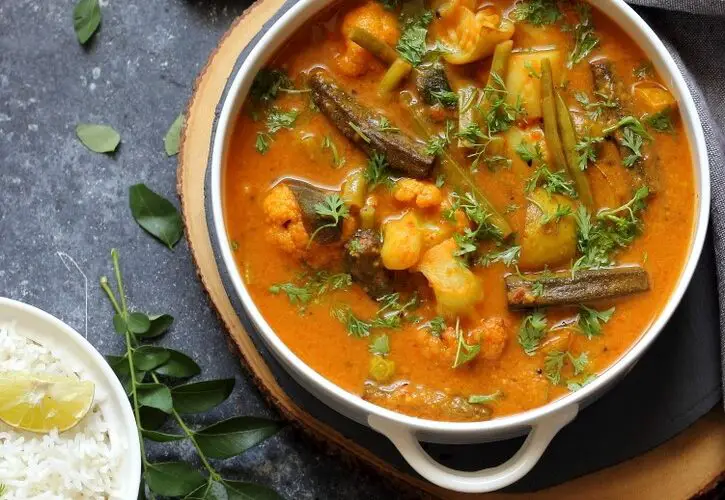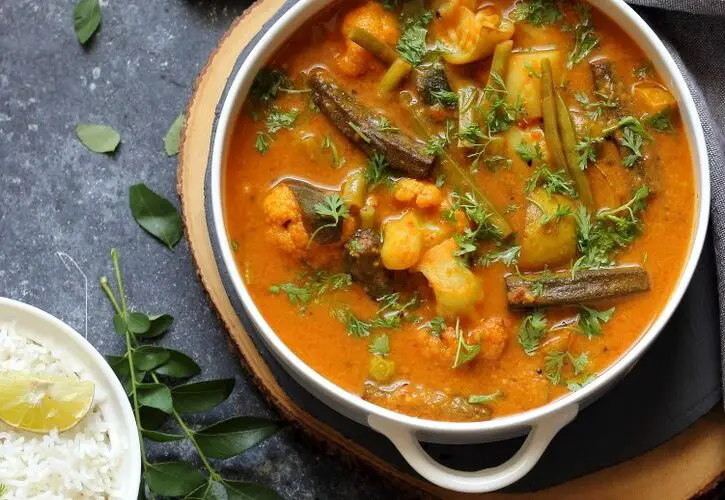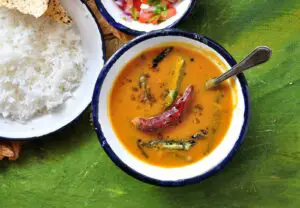A dal and vegetable mixture is added to besan or chickpea flour that has been carefully roasted to create the smooth, silky curry known as Sindhi Kadhi.
I’m sharing a kadhi recipe that I’ve been making for a year. This recipe comes from my mother Although I prefer to add no more than two or three vegetables, she adds a tonne more. Additionally, you might add carrots, green beans, or drumsticks. The secret to this recipe is roasting the gramme flour until it changes colour and releases a nutty scent, making sure to stir constantly to prevent burning.
In contrast to the usual addition of a variety of vegetables, this recipe only calls for okra, which is frequently included in Sindhi Kadhi. It produces a delectable, soothing gravy and has a flavor profile of acidic, sweet, and sour notes. It is indeed a delightful preparation that is sure to satiate your taste buds and your tummy

This vegan curry emphasizes making the most of what you have. Adding any vegetable you have at home to a simple dish. Only a small number is required, but everything comes together flawlessly.
Ingredients For Sindhi Kadhi Recipe
- 100gms bhindi/ okra
- 250gms potatoes boiled and cut into medium chunks
- 100 gm cluster beans
- 1 carrot
- ¼ cup peas
- ½ cup besan or chickpea flour
- Pinch of asafoetida
- 1 tsp cumin seeds
- ½ tsp fenugreek seeds
- 12 curry leaves
- 2 teaspoon Chopped green chillies
- ½ teaspoon turmeric powder
- 1 teaspoon Kashmiri red chili powder
- salt to taste
- 2 teaspoons tamarind paste
- 1-2 dried red chillli
- 4 tablespoons vegetable oil
- 1 tablespoon Jaggery
- 2 teaspoons finely chopped ginger
- 2 tbsp tamarind paste
Instruction for Sindhi Kadhi recipe
- One tablespoon of oil should be added to a deep pan before heating it. Then, add the slit okras and sauté them over a medium temperature until they are thoroughly cooked and have lost their slimy appearance. They will start to crisp up after around 6-7 minutes.
- Transfer these okra onto a plate and set aside to be used later.
- In the same pan heat the remaining oil and warm it. Add mustard seeds, fenugreek seeds, asafoetida, curry leaves, and red chilies in quick succession and let them crackle and crisp up.
- Then add the gramme flour and roast for three minutes while stirring continually. Reduce the heat to a low setting. Spices in powder form should be added and fried briefly. Add tomatoes and cook for a minute. Turn off the heat and slowly pour 500 ml of water into the pan. Mix thoroughly with a whisk, making sure there are no lumps
- Put the pan back on low heat and stir in turmeric powder, Kashmiri red chili powder, salt, and chopped vegetables.
- Cook the vegetables under cover for 8 to 10 minutes, or until they are soft.
- Add the fried okra/ bhindi and boiled potatoes. Simmer for 2 minutes.
- Add tamarind paste and crushed jaggery and mix well
- Garnish with fresh coriander and the remaining curry leaves. Serve warm with rice and something crispy.
Notes
- Use Fresh Yogurt: Fresh yogurt or curd is key to a creamy and tangy kadhi. Avoid using sour yogurt.
- Consistency Matters: Pay attention to the consistency of the kadhi. It should be neither too thick nor too thin. Adjust the amount of water accordingly.
- Soak Tamarind Well: If you’re using tamarind pulp, soak it in warm water to extract its flavor. Strain the liquid and discard any seeds or fibers.
- Tempering Technique: The tempering (tadka) of mustard seeds, fenugreek seeds, and asafoetida is crucial for the unique flavor of Sindhi Kadhi. Ensure the oil is hot enough before adding the tempering ingredients.
- Use a Variety of Vegetables: While traditional Sindhi Kadhi includes okra, potatoes, and drumsticks, you can experiment with other vegetables like eggplant, carrots, and cauliflower to add variety.
FAQs
What vegetables are commonly used in Sindhi Kadhi?
Vegetables like okra (bhindi), potatoes (aloo), drumsticks (sahejan), and eggplant (baingan) are often used in Sindhi Kadhi. You can choose a combination based on your liking.
How long does it take to prepare Sindhi Kadhi?
The preparation time for Sindhi Kadhi may vary, but it typically takes around 30-40 minutes to cook, excluding the time needed to soak the tamarind.
Can I prepare Sindhi Kadhi in advance?
Sindhi Kadhi can be made in advance and reheated when needed. In fact, it often tastes better the next day as the flavors meld together.
What is the best way to serve Sindhi Kadhi?
Sindhi Kadhi is traditionally served with steamed rice. It can also be enjoyed with roti (Indian flatbread) or as a side dish.
Can I freeze leftover Sindhi Kadhi?
While it can be frozen, the texture of the vegetables and the consistency of the kadhi may change upon reheating. It’s best to store leftovers in the refrigerator and consume them within a few days.
Conclusion
In conclusion, Sindhi Kadhi is a delightful and flavorful dish that holds a special place in Sindhi cuisine. Its rich history and unique blend of ingredients, including tangy yogurt, besan (gram flour), assorted vegetables, and aromatic spices, create a symphony of tastes and textures.
Sindhi Kadhi is a versatile dish with numerous variations. You can add besan pakoras, serve it with bhuga chawal, make it with tofu for a vegan version, or experiment with different tangy agents like kokum or amchur. Nutritional additions like greens or chickpeas are also popular. Jain variations omit onion and garlic.
Sindhi Kadhi is not just a dish; it’s a reflection of Sindhi culture and tradition. It’s a flavorful journey that combines diverse ingredients into a harmonious whole, creating a meal that’s both satisfying and culturally significant.
Nutrition
| Calories | 194kcal |
| Fat | 13g |
| Sodium |
767mg
|
| Potassium |
mg
|
| Carbohydrates | 1.2g |
| Protein | 10g |
| Vitamin A |
599IU
|
| Vitamin C |
10mg
|
| Calcium | 71mg |
Also read:
- How to make chenna
- Handi Paneer RecipeBlack Lentils Recipe
- Til laddu recipe (til ke laddu)
- Oats Uttapam recipe
- New York-Style Pizza Recipe:
- Tawa fish fry recipe
- Roast Turkey Recipe:
- Fish and Chips recipe:
- Southern Fried Chicken:
follow us on instagram, facebook and youtube


